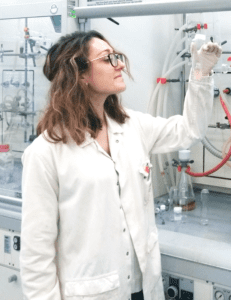Un unprecedent hunt: Molecules with memory at room temperature
A fruitful collaboration within the Institute of Chemical Research of Catalonia (ICIQ) along other international institutions has allowed to demonstrate that a molecular magnetic memory near room temperature is a reality. A new way of storing information has come to light and possess a potential technological impact. Molecular bits are already here.
A new paradigm has appeared at ICIQ, demonstrating that thermal hysteresis is maintained still at single molecules in liquid solution. This has been a really complex and long path where clearly the expertise and knowledge of a team of three research groups was key to success.
Hysteresis is the tendency of a material to retain one of its properties even when the stimulus that has generated it disappears. An illustrative case is when iron is exposed to a magnetic field. It will stay magnetized indefinitely until some energy is transferred to the system (a magnetic field in the opposite direction for example). This magnetic memory effect is the base for recording information into some types of hard drives.
The advantage of small components that can store information is clear in terms of space and energy consumption. Until now, single molecule magnets (SMMs), promising molecular materials which represent the ultimate miniaturization unit have been developed. However, they required very low temperatures (–193 ºC) for proper function because magnetic memory effect is rapidly lost by thermal activation at the nanoscale.
The appearance of a memory effect at the single molecule level, even upon dilution, was found in a spin crossover (SCO) molecule, a polyanionic iron complex. The classic, well-accepted elastic model for SCO systems precluded the appearance of molecular bistability, since a memory effect would only be allowed when a crystallographic phase transition in bulk took place. Thus, this discovery breaks previous expectations.
The presence of memory effect in this polyanion around room temperature was confirmed by plenty of complementary experimental evidences, including magnetic and spectroscopic techniques, both in diluted solid mixtures and liquid phase. All of them consistently demonstrated the appearance of a genuine single-molecule memory effect. These results represent a successful team effort, after almost eight years, from the groups of Prof. José Ramón Galán-Mascarós, Prof. Mónica H. Pérez-Temprano and Prof. Julio Lloret-Fillol.
“Extraordinary claims require extraordinary evidences, which could only be delivered by a complementary effort from multiple techniques and multiple backgrounds. ICIQ lead, but we were lucky to gather a unique, interdisciplinary team”, says Galán-Mascarós. “Our long-time experience in NMR to elucidate reaction mechanisms in organometallic chemistry was key to investigate this new phenomenon. A very different problem that we could successfully tackle with a fresh mind, looking out-of-the-box”, concludes Prof. Pérez-Temprano.
The computational analysis, lead by Prof. Eliseo Ruiz (Universitat de Barcelona), identified the origin of this novel phenomenon at the appearance of strong intra- and supra-molecular interactions, able to slow down the relaxation processes at the single molecule level, and thus opening a kinetic thermal hysteresis. Obviously, previous SCO theory is not being refuted, but the appearance of this unexpected molecular property could not be predicted until this moment.
The discovery of this slow relaxation process, which seemed impossible, is basic research now but these results may certainly represent a revolution in the field of spin transition phenomena, since SCO single molecules are opening exclusive opportunities for molecular data storage at technologically relevant temperatures. A new way of storing multifunctional (optical or magnetic) information has appeared and suggests that it is the tip of a great iceberg of new possibilities.
The impossible is the science that has not yet been discovered and at ICIQ an impossible has been brought to light.
Reference article:
Moneo-Corcuera, A., Nieto-Castro, D., Cirera, J., Gómez, V., Sanjosé-Orduna, J., Casadevall, C., Molnár, G., Bousseksou, A., Parella, T., Martínez-Agudo, J.M., Lloret-Fillol, J., Pérez-Temprano, M.H., Ruiz, E. & Galán-Mascarós, J.R. Molecular memory near room temperature in an iron polyanionic complex. Chem. https://doi.org/10.1016/j.chempr.2022.09.025
